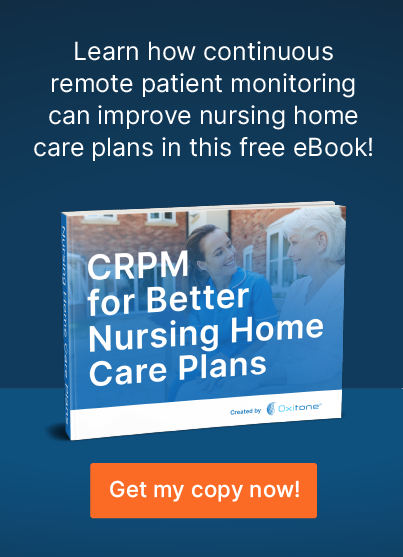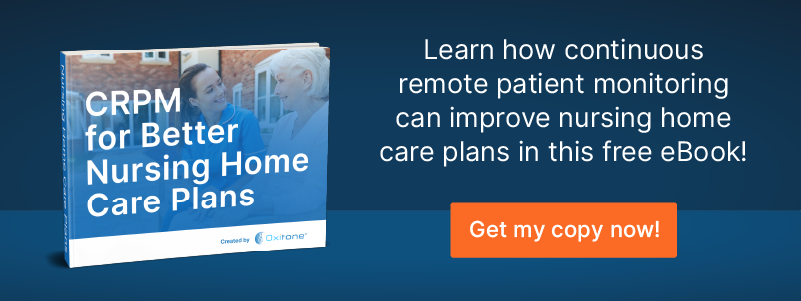Remote patient monitoring (RPM) has become an essential component of post-COVID care for patients, especially those who have been released from the hospital or who continue to experience symptoms of COVID-19 long after testing negative (aka “long-haulers”).
However, RPM kits given to COVID patients often come with many pieces, including blood pressure cuffs, pulse oximeters, and weight scales. These extensive kits can be confusing and difficult for patients to comply with.
Ideally, patients should use one multi-parameter device that could be added to their post-COVID care plan to track all these measures via a single, easy-to-use wearable. That device is called Oxitone.
Let’s discuss the limitations of traditional RPM kits for COVID-19 patients and how Oxitone’s convenient wearable medical devices can help your practice address these issues.
Limitations of COVID-19 RPM Kits
Patients released from the hospital after a COVID-19 infection are at a high risk of experiencing post-COVID complications, including systemic inflammation and “long-haul” symptoms.
Physicians need a way to follow up with these patients without putting others in their practice at risk of infection, hence the use of RPM. Many hospitals, including the Mayo Clinic system, use RPM kits to support their patients at home after their release from the hospital.
These RPM kits track blood pressure, oxygen saturation, body weight, and more, without asking infectious patients to return to a hospital or clinic for follow-up appointments. The use of RPM for post-COVID patients is crucial because it can reduce readmissions and save hospitals time and money.
RPM tracks variables that are predictive of future complications, helping physicians address potential problems before they can arise. But it must be done in a way that ensures patient compliance, so doctors are receiving consistent, accurate data.
Unfortunately, the RPM kits currently used by Mayo Clinic and other hospitals have a critical limitation: they include multiple pieces, such as a blood pressure cuff, pulse oximeter, weight scale, and digital tablet.
Since even healthcare professionals require specialized training to use some of these devices, they are not intuitive for patients. If they find the RPM kits too difficult, time-intensive, or complicated to use, they may not keep up with their remote follow-up care, placing them at higher risk of complications and readmissions.
Also, the use of sophisticated digital technology, such as iPads, in these RPM kits is of particular concern among the population aged fifty-five and older. These patients are at the highest risk of experiencing a severe COVID-19 infection that requires hospitalization, as well as many post-COVID complications, yet they may also have the most difficulty navigating this modern technology.
Patient compliance creates a burden for hospitals and clinics in terms of healthcare costs. If patients do not use their RPM kits more than 50% of the time (defined as sixteen out of every thirty days), health insurance companies—including Medicaid plans—may not cover RPM services, requiring hospitals and patients to pay the high cost of care.
Why Oxitone Should Be a Part of Your Post-COVID Care Plan
So, how should hospitals and clinics address these RPM limitations when establishing their post-COVID care protocols? For starters, they should consider the technology available to them and strive to choose RPM products that are simple and intuitive for all patients to use.
We recommend using Oxitone 1000M in your post-COVID care plans because unlike other RPM kits, it is a single, wearable device that is easy for patients to comply with, providing physicians with actionable data.
Oxitone goes beyond RPM: it is a continuous remote patient monitoring (CRPM) device. This means it transmits a steady stream of patient data around the clock.
As long as the patient continues to wear the device, physicians will have access to hypoxia index, COVID-19 screening symptoms, and other relevant metrics for post-COVID care, sending smart signals to providers only when the data warrants further attention.
Not only does this save healthcare systems time and money, but it also improves patient compliance, ensuring access to their potentially life-saving data. Since Oxitone is a comfortable, wrist-wearable device, comparable to a fitness tracker, many patients are already familiar with the interface and are more likely to wear it.
Comparable to wearable emergency alert systems used in assisted living facilities, this wearable technology is easy for even elderly patients to use, who can put it on their wrist and essentially forget about it. One might even say that the device is difficult to use incorrectly!
Increased patient compliance as a result of simplified technology results in better insurance coverage, more comprehensive care, fewer readmissions and complications, and lower out-of-pocket costs for patients and hospitals alike.
Most importantly, however, Oxitone combines all the elements of a post-COVID RPM kit into one multi-parameter device. Physicians will receive all the same data that they would expect to receive from a standard RPM kit, only with more consistency and higher quality due to better patient compliance.
Here at Oxitone, we boost value-based healthcare by delivering extraordinary patient, clinical, and economical outcomes at reduced medical utilization and cost. Patients need a prompt response to emergencies. Physicians need an easy and timely follow-up with patients. Our mission is to transform chronic disease management and help save lives worldwide.
Let’s save lives together! To see how we help remote patient monitoring companies and physicians improve the management and care of high-risk patients, contact us today!


